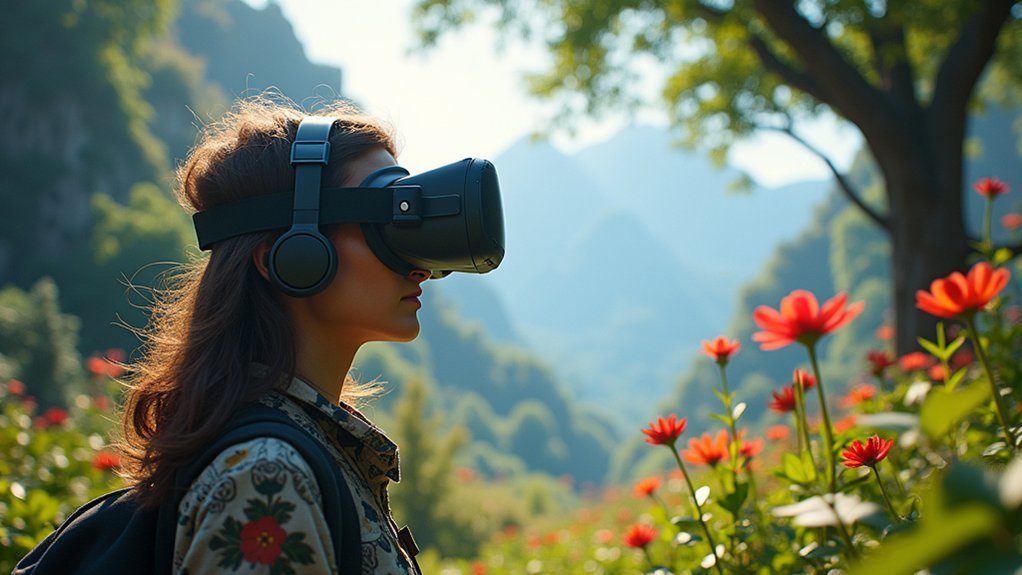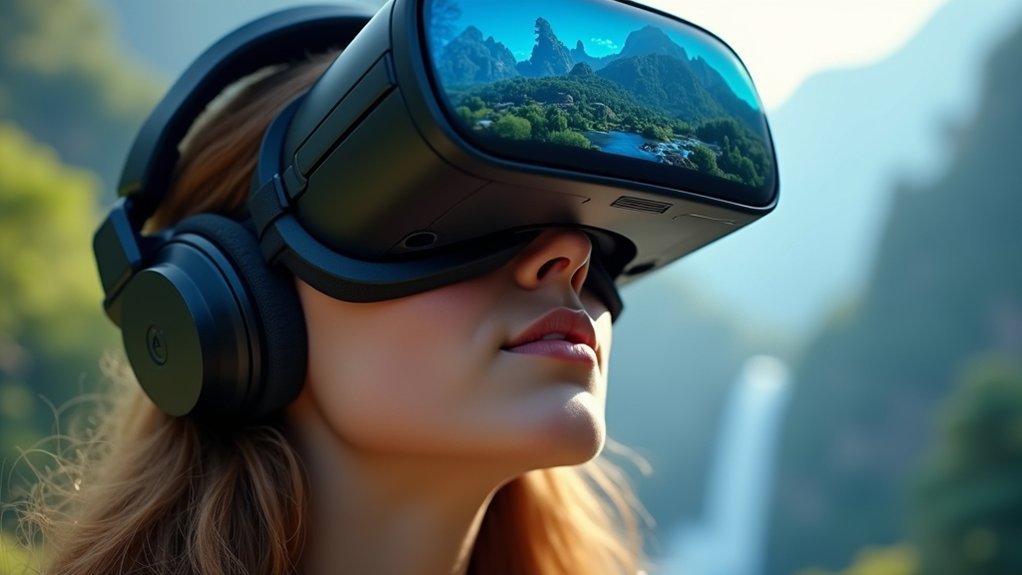FOV enhancements transform your VR experience by expanding your visual range from a restrictive 90-degree tunnel to an immersive 120+ degree panorama that mirrors natural human vision. You’ll experience dramatically improved spatial awareness, eliminating the uncomfortable “window-looking” sensation that causes motion sickness and fatigue. Dynamic FOV adjustments automatically optimize your comfort during intense movements, while advanced optimization techniques boost resolution and frame rates. These innovations create seamless immersion that’ll fundamentally change how you perceive virtual environments.
Understanding Field of View in Virtual Reality Technology

How does your brain process the vast visual information streaming through a VR headset? Your perception depends heavily on FOV, which determines how much of the virtual reality (VR) environment you’ll see at once.
Standard headsets offer 90-110 degrees, while premium models exceed 120 degrees for a more immersive experience. A wider FOV dramatically improves user engagement by mimicking your human eye’s natural visual range.
You’ll feel less confined and more connected to virtual worlds. However, finding ideal FOV settings requires careful balance—too narrow creates tunnel vision, while excessive width triggers motion sickness.
Your user comfort relies on proper FOV calibration. Content placement within your comfortable visual range minimizes awkward head movements, creating smoother interactions that keep you engaged longer without fatigue.
How FOV Width Impacts Immersion and User Engagement
When you expand your FOV beyond the standard range, you’ll immediately notice how peripheral vision transforms your virtual experience from a window view into true immersion. Your spatial awareness improves dramatically as wider FOV eliminates tunnel vision effects that break the feeling of presence in any virtual environment.
| FOV Range | User Experience Impact |
|---|---|
| 60-80° | Limited immersion, tunnel vision |
| 90-110° | Ideal FOV settings for most users |
| 120°+ | Maximum spatial awareness |
| Dynamic FOV | Adaptive comfort enhancement |
| Narrow FOV | Increased discomfort or motion sickness |
Research confirms that user engagement peaks when virtual reality (VR) systems provide ideal FOV settings between 90-120 degrees. You’ll experience less motion sickness while enjoying prolonged sessions. Dynamic FOV adjustments further enhance your immersive experience by automatically optimizing comfort levels throughout your virtual journey.
Dynamic FOV Adjustments for Motion Sickness Reduction

Although traditional VR systems maintain static FOV settings, dynamic FOV adjustments actively combat motion sickness by automatically narrowing your peripheral vision during intense movement sequences.
This VR technology aligns visual and inertial sensory input, considerably reducing discomfort during immersive virtual reality sessions. Research with Oculus Rift DK2 users demonstrates that FOV restrictions allow you to enjoy longer VR experiences without nausea symptoms.
You’ll appreciate that these adjustments operate seamlessly—15 out of 30 participants showed no participant awareness of FOV changes during testing.
Dynamic FOV adjustments enhance user comfort while maintaining engagement levels. The minimal processing overhead makes this motion sickness reduction technique particularly attractive for developers seeking to improve overall experience quality without compromising performance or immersion.
Software Optimization Techniques for Enhanced Visual Experiences
Beyond hardware-based FOV adjustments, software optimization techniques reveal remarkable visual enhancements that directly impact your VR experience quality. Efficient rendering techniques boost frame rates while adaptive FOV systems dynamically adjust viewing angles based on your movements, creating smoother immersive experiences.
| Optimization Technique | Performance Benefit |
|---|---|
| Advanced texture streaming | Higher resolution within FOV |
| Spatial audio integration | Enhanced spatial awareness |
| AI-driven algorithms | Predictive movement adjustments |
These performance optimization strategies work synergistically to transform your virtual environment. Visual FOV enhancements combined with spatial audio create compelling sensory experiences that reduce motion sickness. AI-driven algorithms predict your next movements, preemptively adjusting FOV settings for seamless navigation. This intelligent software optimization guarantees you’ll experience consistently high frame rates without sacrificing visual fidelity.
The Relationship Between FOV and Spatial Awareness in VR

Since your brain processes spatial information through peripheral vision cues, FOV width directly determines how effectively you’ll navigate and interact within virtual environments. A wider FOV between 90-120 degrees transforms your immersive experience by eliminating tunnel vision that restricts natural movement.
Here’s how ideal FOV enhances your VR sessions:
- Enhanced spatial awareness – You’ll perceive more of the virtual world simultaneously, improving navigation accuracy.
- Increased user comfort – Reduced neck strain from excessive head movements during exploration.
- Better engagement – Natural visual range mirrors human vision, keeping you fully absorbed.
- Improved interaction – Vertical content placement within comfortable viewing angles enhances responsiveness.
Modern VR headsets prioritizing wider FOV deliver superior spatial awareness, making virtual environments feel genuinely three-dimensional rather than restrictive viewing windows.
Advanced FOV Technologies Shaping Future Virtual Environments
You’re witnessing a transformation in VR technology where next-generation optics are pushing FOV boundaries beyond what seemed possible just years ago.
These revolutionary lens systems aren’t just expanding your visual range—they’re maintaining crystal-clear image quality across the entire field of view.
Meanwhile, dynamic FOV adaptation systems are learning your preferences and automatically adjusting your visual experience in real-time, creating personalized virtual environments that respond to your unique needs.
Next-Generation Optics Revolution
While traditional VR optics have long constrained field of view within narrow parameters, revolutionary advances in next-generation optics are fundamentally transforming how you’ll experience virtual environments.
These adaptive optics innovations deliver unprecedented FOV enhancements that create truly immersive experiences.
Four breakthrough technologies are reshaping virtual reality:
- Varifocal lenses – Dynamically adjust focal depth to mirror natural human vision patterns
- Pancake optics – Reduce headset size while expanding FOV beyond 200 degrees
- Light field technology – Captures extensive depth information for realistic 3D perception
- Micro-OLED displays – Boost pixel density while enabling wider FOV without quality loss
Dynamic FOV adjustment lets you personalize viewing parameters in real-time, enhancing user engagement.
This display technology revolution guarantees you’ll enjoy comfortable, natural vision that maximizes immersion while minimizing discomfort.
Dynamic FOV Adaptation
As headset sensors track your eye movements and body motion in real-time, dynamic FOV adaptation automatically adjusts your field of view to create the most comfortable and immersive experience possible.
You’ll benefit from reduced motion sickness when your gaze direction and movement speed trigger automatic FOV restrictions. This technology enhances rendering performance by decreasing computational demands on your peripheral vision areas while maintaining superior visual quality where you’re actively looking.
You won’t even notice these seamless adjustments happening, yet you’ll find your VR applications more engaging and enjoyable.
User feedback consistently shows preference for this adaptive approach, which developers can easily integrate into existing systems.
Dynamic FOV adaptation delivers both improved user comfort and optimized performance, making it essential for next-generation virtual environments.
Frequently Asked Questions
What Is the Ideal Fov for VR?
You’ll find the ideal VR field of view ranges from 90 to 110 degrees, though high-end headsets exceed 120 degrees. This wider FOV mirrors your natural vision, creating more realistic and engaging virtual experiences.
Why Is VR so Immersive?
VR tricks your brain into believing you’re somewhere else by engaging multiple senses simultaneously. You’ll experience visual depth, spatial audio, and responsive movement tracking that creates convincing presence within digital environments.
What Is the 20/20 Rule for VR?
You’ll want to follow the 20/20 rule, which requires maintaining at least 20 degrees of vertical and horizontal field of view to prevent motion sickness and guarantee comfortable, immersive VR experiences.
How Can I Make My VR Experience Better?
You can improve your VR experience by adjusting FOV settings for comfort, choosing headsets with wider fields of view, positioning content within comfortable viewing angles, and gathering user feedback for personalized optimization.





Leave a Reply